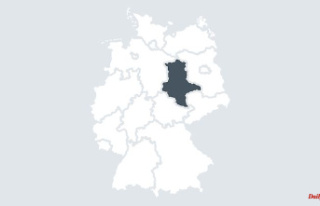Saxony-Anhalt's digital minister wants "5G on every milk can". A lot has happened in the past few months, but the country is still a long way from nationwide, fast 5G Internet. The state government now wants to facilitate the processes.
Magdeburg (dpa/sa) - The expansion of 5G mobile communications technology in Saxony-Anhalt has picked up speed - but there is still room for improvement. The 5G availability in Saxony-Anhalt is around 74 percent overall, according to the Digital Ministry in Magdeburg, citing data from the Federal Network Agency from July 2022. The abbreviation 5G stands for the 5th generation of mobile communications, which is the further development of 4G (LTE).
The country has recently made great strides, especially with the latest 5G development stage, which is also known as "5G standalone". Almost 58 percent of the country is now covered by at least one provider with this even faster 5G technology. In October 2021, the latest standard was only available on 0.6 percent of the country.
However, part of the expansion area is covered by what is known as Dynamic Spectrum Sharing (DSS) technology. The antenna switches back and forth between 4G and 5G - depending on the needs of the users in the area. Therefore, this is also understood as part of the 5G coverage. DSS was already available on just over 44 percent of the country's area in October last year, and in July the proportion was just under 59 percent.
There is still a lot to be done before “5G is available on every milk can”, as Infrastructure and Digital Minister Lydia Hüskens (FDP) would like. According to a spokesman for the ministry, there is still some catching up to do in all regions of the country, especially where there are topographically difficult conditions - for example in the Harz Mountains.
A spokesman for the Digital Ministry explained that the 5G expansion is currently based on the upgrading of existing 4G cellphone sites. In some places, these are not yet connected with fiber optics, which requires additional civil engineering work. Due to the current market situation, it is not always possible to commission the work quickly. The location search also causes problems. Finding suitable areas, especially in rural areas, often takes a lot of time. The speed of the expansion also depends on the concrete investment decisions made by the mobile phone providers.
In order to facilitate the expansion of the mobile and 5G network, the cabinet is working on a draft law to amend the state building code on Tuesday. Specifically, it is about, among other things, a new regulation on the distance areas, which will no longer apply to small outdoor systems in the future. In addition, radio masts up to 20 meters high should be able to be erected without any procedure in the future.
A few regions are not yet connected to a high mobile communications standard. The proportion of so-called white spots - i.e. areas where no network provider offers at least the 4G standard - is 3.3 percent nationwide.












